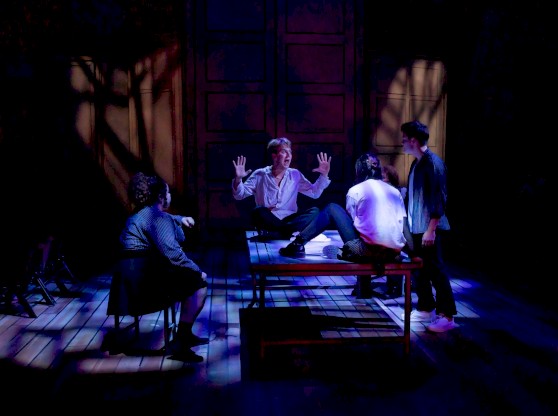Upcoming visiting artist Jiha Moon is a contemporary artist who specializes in printmaking, painting and ceramics. The Korean-born artist lives and works in Atlanta, Georgia. She received her MFA from the University of Iowa in Iowa City, and her BFA from Korea University in Seoul, Korea. Moon's diversity of approaches and experiences contribute character to her works, which are emblematized by a mesh of Western and Eastern cultural references.
Ashlyn Diaz is an artist born and raised in St. Petersburg, Florida. She is currently a senior drawing major at the School of Art + Art History. Her work is a collection of studies that involve both traditional and unconventional drawing materials, which often translate into video, book arts and weaving. She is actively involved in the painting and drawing community and is the treasurer of the University of Florida’s Painting and Drawing Association.
Ashlyn: What impact do you hope to have on your audience by exposing the inauthenticity of preconceived notions?
Jiha: I think people often misunderstand what authenticity means. We all are attracted to an idea of authentic stuff that we often are mistaken by it. For example, I get a question, “Why do you frequently use fortune cookies in your art? You are not even Chinese!” Yes, I am not Chinese but fortune cookies are an American invention.
Ashlyn: Is it important that you assume the role of a traveler when creating works? If so, why? How did the persona of “the traveler” come about?
Jiha: For me, “travel” is to experience other worlds. Ultimately, besides ourselves, everyone else in the world can be seen as “others.” The places we have to go without knowing can be other world. I am not only talking about traveling to other countries but also including driving or walking around neighborhoods that we did not know before. I think we are exposed to experiences in new places, with new people and new things on an everyday basis. We are all travelers.
In my work I always try to invite new elements that are not only Korean influenced but other things that also impact my ideas at the moment. I see this as foreign elements negotiating with existing elements in my work, and this is an important and necessary process.
Ashlyn: What is your process for titling a work or body of works?
Jiha: It usually comes naturally based on what I am working on at the moment. I consider titles quite important. I think they are important cues for viewers to grab their interest and spark their imagination. It is an opportunity for me to explain my work but super short and essential, like poetry. I try to be good at it, but it is not always easy.
I like to work in series with my work, because by doing this I spend more time to develop a body of work. I try to give enough time for each project.
Ashlyn: Who are some artists that influence you?
Jiha: My influences come from everywhere. I am not digging through art history books all the time, but I certainly love old masters, work from both East and West. At the moment I am looking at a lot of folk art all over the place. I look at Hopi Kachina dolls, Korean masks and quilts, Mexican masks and quilts, and African masks and artifacts. I also look at ceramic patterns such as Blue and White, Blue Willow, Blue Onions and Delftware. I look at ugly face jug traditions in the South. I am also learning all types of traditional hand-knotted styles in Korea and elsewhere. Also, I am learning about many new hair dreadlocks and braids for my ongoing Norigae works.
Ashlyn: As a(n) artist/mother/teacher/wife that has proven excellence in studio practice, what advice do you have for young artists in regards to how to preserve studio time amidst life's demands?
Jiha: I go to my studio every day even though sometimes I can only spend 30 minutes. The studio also doesn’t have to be fancy. I have had a studio as big as 700 square feet to just one little table in my tiny bedroom. A studio is where I make my work. I try to be flexible and adapting in my situation. Mostly, I try to have fun with it. For me, my art and my life are almost one thing and I try not to draw a line in between. They both constantly affect and influence each other. It is quite tiring sometimes, but I try to enjoy it. I love being a woman and a mother and an artist. It is a huge challenge when you put all those three things together. For young artists, my advice is to try to enjoy what you do. See if you love doing it despite all the facts. Then, you must be an artist.
For a more in-depth conversation with Jiha Moon, join the School of Art + Art History for her exhibition opening on Thursday, December 3rd at the Grinter Gallery, 4:00-6:00pm and Jiha’s artist talk on December 3rd at 7:00pm in Fine Arts Building B, Room 103.
Exhibition Reception: Grinter Gallery, Thursday, December 3, 2015, 4:00-6:00pm
Exhibition Dates: Grinter Gallery, December 3, 2015 – February 5, 2016
Artist Talk: Fine Arts Building B, Room 103, Thursday, December 3, 2015,7:00pm
Jiha Moon's exhibition Meaningful Object showcases a collection of works influenced by everyday objects, artifacts and cultural signifiers, and includes paintings, ceramic objects, and prints. This exhibition and artist talk is organized by Assistant Professor Lisa Iglesias, School of Art + Art History, liglesias@arts.ufl.edu.
Jiha Moon's visit is sponsored by the Center for the Humanities and the Public Sphere with support from the Yavitz Fund. Co-Sponsored by the Marston Fund and Asian Pacific Islander American Affairs.
Meaningful Object exhibition: Grinter Gallery, located in the lobby of Grinter Hall on campus. 1523 Union Road, Gainesville, Florida 32611



